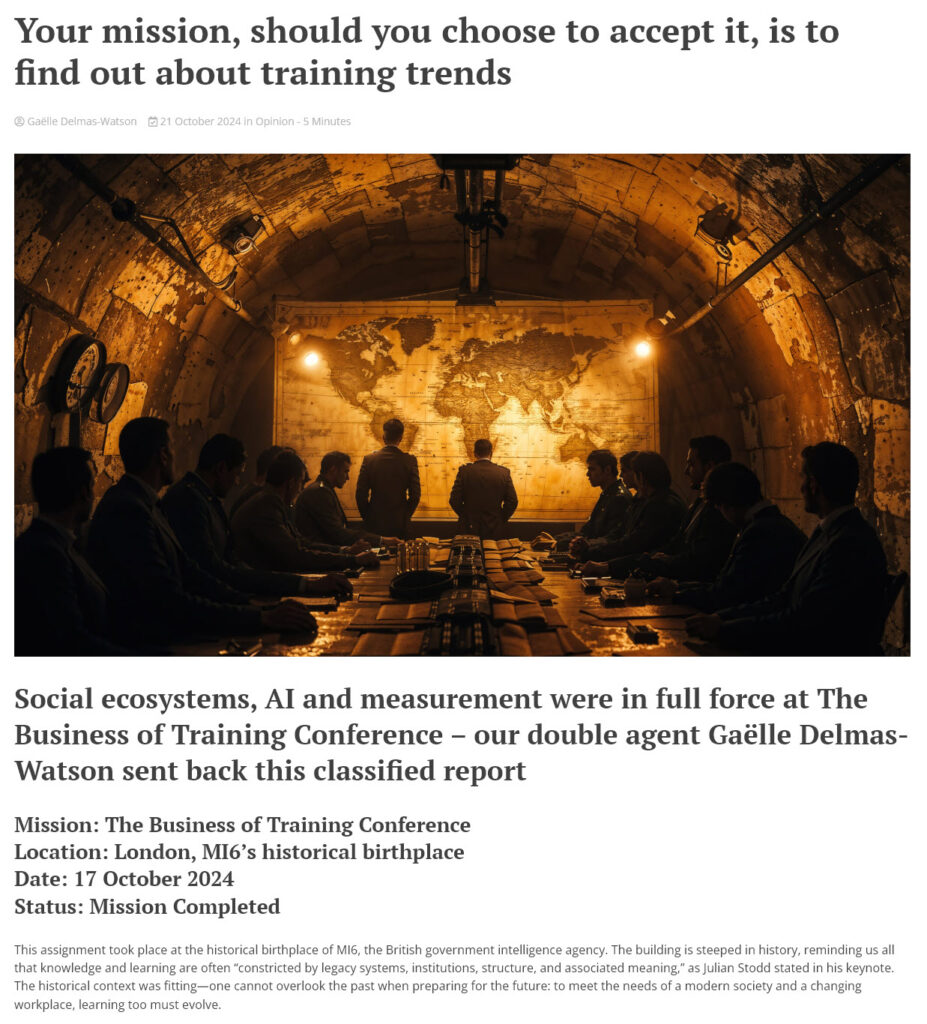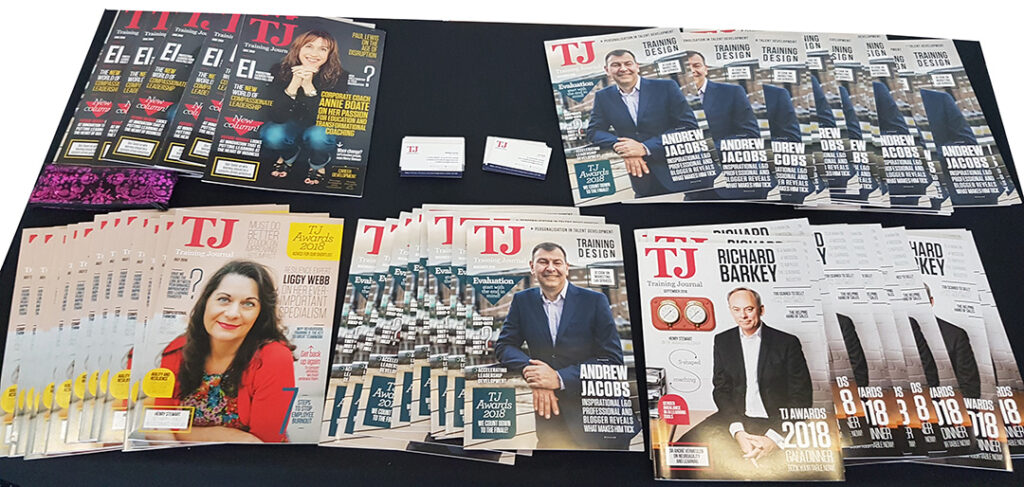What does being the Editor of a learning content website
involve? Jo Cook enlightens us
I developed a desire to write when I was 12 years old and was always drawn to periodicals rather than newspapers or novels. I have no idea why; it just seemed to happen naturally. My role for Training Journal is part time (currently just one and a half days a week) and, being the creative person I am (my mum would say awkward), I’m flexible on timing around my other work.
Everything you read, watch or listen to on TJ is my fault!
The role of Editor means I’m responsible for all aspects of TJ on a daily basis. Total Politics, the company that owns TJ, has a team that includes sales, marketing and other support systems, and I’m loving the mix of working with a larger team while still being autonomous. So everything you read, watch or listen to on TJ is my fault!
Standard tasks
There are some regular things I do every week for TJ – on Tuesdays I research and write the Newsflash, and more recently, record a short News Insight podcast to go with it roughly once a fortnight. I start with the press releases that arrive via email, of which there are a LOT. Not everything makes the cut, including: “Areas it will take the least time to save for an engagement ring” and “Countries with restrictions on travelling with adult toys” – yes, really.
One of the things I’ve enjoyed since taking the role at TJ is developing further relationships within the L&D industry. One of those is with Rob Clarke at Learning News, who does a great job getting information out there that I wish to amplify to you all, so a lot of news comes from Rob’s great work.
Another important weekly task is the newsletter. This is a great way to highlight the articles published that week on the website, along with writing an editorial. It can be a bit intimidating to come up with something useful, interesting and, hopefully, thought-provoking each week – but it’s also a great way to lean in to those skills of synthesising the information I’m seeing in the people profession.
Editing articles
A lot of the time at TJ is obviously spent in sourcing, editing and publishing the articles you see on the website. I’m very grateful for everyone who pitches ideas and there are very few that I turn down, such is the variety and quality that comes in.
It’s sometimes a little challenging to have to go back to an author or public relations agency and feedback that I don’t publish about learning styles, something is perhaps too commercial (though they can advertise with TJ, which is what keeps the content free), or they are missing links to research in order to ensure that the material is credible. Everyone just wants to do a great job and get their content seen, which makes it a pleasure to work with them.
Publicity for people
There’s often a conversation on social media or in networks about doing things for free in order to get “exposure”. I understand the people who say that if someone is making money off the back of your work, you should get compensated for it. This is often used when talking about conferences where there are high ticket costs and little or no compensation for speakers. The rebuttal of: “I’ll speak to the mortgage company and see if I can pay them in exposure” is a powerful one.
It’s about getting your experience, point of view and name out to people who are looking for speakers and experts to hire
I find I’m now in the position of inviting people to contribute to TJ without any financial payment. I obviously highlight our 13,000 website visitors a month, more than 11,000 followers on LinkedIn, 5,000 newsletter subscribers and much more. It’s also about the advantages of getting your experience, point of view and name out to people who are looking for speakers and experts to hire. I’m very honest with people, making it clear that I want to support them and their message, to give them a platform to share their experience and expertise, while also helping support the development of our industry.
I’ve built my own career and professional profile that way – through my own blog, writing for many other organisations, being a guest on podcasts, webinars and panels, a conference speaker and more. As I’ve taken on these opportunities and built a reputation, some of it has led to financial compensation, though more often it hasn’t. Any public unpaid work I’ve done, I allocate to the ‘marketing’ budget or time resource. This approach might not be for everyone and I respect that, but it seems to work for those of us who choose to follow it.
Publishing and promoting
The publishing side of articles is relatively easy. The website is hosted on WordPress, which I’ve used for over a decade. I try to edit articles in batches and schedule them for the week ahead. One day I hope to get a couple of weeks ahead of myself – one can dream!
I’ve also found some good technology solutions:
- I have a WordPress plugin for sourcing article images directly from corporate Adobe Stock Images, Unsplash and other accounts (StockPack).
- Another plugin create social media posts from the article once it’s published (WP to Buffer Pro).
- Yet another allows me to highlight a specific podcast on a page so that you can listen to it in context of the relevant information, such as a summary or transcript (Podcast Player).
- For the podcast, I use a variety of tools. TechSmith was kind enough to provide Audiate for six months. I now use a mixture of Camtasia for editing and CleanVoice for the audio clean-up and transcript.


It’s been interesting trying to find the right time-saving solutions that are also cost-effective. The social media plugin is setup to use the title and first 15 words of the article (the standfirst, which is the big bold bit that tells you about the article) as the post.
This means rather than writing “Bob looks at topic X”, they are written more like “Topic X is important, and Bob looks at it”. It’s interesting trying to write the first 15 words so they work as an intro and a social media post.
Commercial aspects
My role is editorial, which means I focus on the content and what’s right for the TJ audience. One of the reasons I was hired was my experience in L&D, and that comes into my decisions about which content, media and partnerships are right for everyone involved.
TJ is no longer a print magazine, those costs became too high in 2020, and we are now a website with exclusive, new content every working day, completely free. This obviously has to be paid for somehow, and that’s through the advertising, paid-for articles, partnerships (that generate interest rather than money) and other commercial elements.
Oliver is responsible for the business development aspects of TJ, and our roles are specifically separate. This means that sometimes he asks me not to do something, and vice versa! Our roles are very different but we work closely. Obviously, the better the content and more people we can get in front of, the better that is for our commercial client; and the better commercial partnerships we have, the more that serves our readership.
Some weeks that means being on virtual calls with prospective clients, telling them about TJ and the ethos I have as Editor. Other times it might be both of us at exhibitions, speaking to vendors about commercial options at TJ. Most recently we’ve collaborated on the readership survey to find out a bit more about you all and what you like, or not, at TJ. That’s been really useful to make future decisions.
Stuff that’s annoying
Any job, no matter how good it is or how much we love it, has stuff that’s annoying, and of course TJ is no different. My biggest challenge is time, meaning I have to be selective about what I focus on each day, including whether to attend industry events. Every half-hour meeting I book is an article I’m not editing and publishing.
The reality is that we have a firehose of information coming at us
At the time of writing, I have 634 emails in my inbox. I despise that. It’s a ridiculous state to be in. I hate being chased (as understandable as that is), and sometimes missing deadlines or taking too long to respond to people – all of whom are very understanding. No matter our role or how many days/hours we have in it, the reality is that we have a firehose of information coming at us. I could work 80 hours a week and probably still wouldn’t reach a zero inbox on Friday, which I like (liked!) to do.
I do enjoy reading and editing the articles and crafting the social media messages and discussions. However, when I do it too much it can be a little monotonous. It’s interesting to ponder some of these things – as I know I’m good at process, good at detail, but too much detailed work and my mind starts to wander. That’s why the right technology working for a processes is so important.
Stuff that’s fun
Speaking of tech, obviously AI has an impact on my TJ work too. I don’t use AI to write whole articles, apart from one experiment that was labelled as such. However, I do use it for summaries of the podcast and sometimes for social media posts. It really helps on those brain-fog days when I’ve written something I know isn’t quite right.
I don’t trust AI completely, but it’s great for getting ideas and suggestions that I use as a springboard. I also used it recently to put together a spreadsheet to help me track all the partnership agreements, as there are a lot of details and deadlines I don’t want to miss.
It’s immensely satisfying to see people’s delight and increasing confidence when they get published on TJ
I love going to industry events, discussing and learning from amazing speakers and participants. It cements my knowledge of what lovely people there are in our industry and the amazing work they are doing. When I speak to people and invite them to contribute to Training Journal, I emphasise that it’s their experience and point of view I’m interested in. Their copy can be edited, but I don’t expect to share the perspective of everyone I publish, and that diversity of thought and opinion is important to help improve our industry. I also love encouraging people to write an article when they thought it was something they couldn’t do; it’s immensely satisfying to see people’s delight and increasing confidence when they get published on TJ.
While editing the TJ podcasts has been more time and effort than I ever anticipated, the feedback on the format that isn’t the standard interview or panel discussion has been overwhelmingly positive and helps me on those days where I’m head-down in editing mode!
When I worked on Training Journal previously, I loved the breadth the work gave me across the industry. I’ve long known that I work well with variety in my job, and having a part-time role here, along with my other work, means that they all inform each other. Long may it continue.
Jo Cook is Editor of Training Journal, and learning and development specialist at her company Lightbulb Moment





